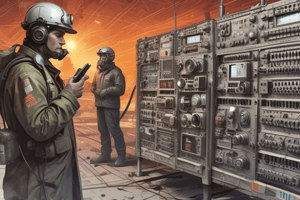Podcast
Questions and Answers
What should you do immediately after realizing that CAD is down?
What should you do immediately after realizing that CAD is down?
Notify the Officers on the radio.
Which City departments share the radio system?
Which City departments share the radio system?
- Private security
- Only Police
- City Hall
- Police, Fire, and Public Works (correct)
Emergency services have the lowest priority on the radio system.
Emergency services have the lowest priority on the radio system.
False (B)
What will display the Officer's badge number on the radio system?
What will display the Officer's badge number on the radio system?
Your primary assigned channel will take precedence over all _____ activity.
Your primary assigned channel will take precedence over all _____ activity.
What is a common mistake in using the radio?
What is a common mistake in using the radio?
Multi-tasking is not necessary in a dispatch environment.
Multi-tasking is not necessary in a dispatch environment.
Voice control will have a definite impact on _____ operations.
Voice control will have a definite impact on _____ operations.
What should a dispatcher maintain while using the radio?
What should a dispatcher maintain while using the radio?
What should you do before transmitting on many incidents?
What should you do before transmitting on many incidents?
What is the main goal of a Communications Officer during shift change?
What is the main goal of a Communications Officer during shift change?
What should a Communications Officer do if console equipment is malfunctioning?
What should a Communications Officer do if console equipment is malfunctioning?
A Communications Officer can predict call volume on holidays with certainty.
A Communications Officer can predict call volume on holidays with certainty.
What should Communications Officers prioritize first?
What should Communications Officers prioritize first?
What is the average duration of the Trainee’s rotation for on-the-job training?
What is the average duration of the Trainee’s rotation for on-the-job training?
Communications Officers are required to have 100% accuracy in their reports.
Communications Officers are required to have 100% accuracy in their reports.
The Communications Officer must check the ______ when an Officer has been on scene for 5 minutes during a high priority call.
The Communications Officer must check the ______ when an Officer has been on scene for 5 minutes during a high priority call.
What should be done when prioritizing calls for service?
What should be done when prioritizing calls for service?
What is the protocol for a priority call dispatch over the radio?
What is the protocol for a priority call dispatch over the radio?
Communications Officers should never conduct personal communication over ______.
Communications Officers should never conduct personal communication over ______.
What action is taken if there are equipment malfunctions during operations?
What action is taken if there are equipment malfunctions during operations?
Flashcards are hidden until you start studying
Study Notes
Preparation for Dispatch
- Shift change is crucial; Communications Officers must complete verbal briefings and log off on time.
- Check status monitors to ensure location consistency before logging in.
- Familiarize with all ongoing incidents and dispatch calls as soon as logged in.
- Anticipate high call activity, especially during specific events (e.g., New Year's Eve).
- Recover after high workload periods by verifying commands and taking personal breaks when necessary.
- Knowing available resources in the communications center enhances multi-tasking capabilities.
Roles and Responsibilities of Communications Officer
- Responsible for dispatching police calls for service based on priority levels (Priority 1-3).
- Maintain awareness of unit status and provide timely updates to field units.
- Communication includes processing information for traffic stops and responding to updates from officers.
- Officer safety is paramount in all communication practices.
Equipment and Systems Used
- Proficiency in Computer Aided Dispatch (CAD) system, Motorola Radio, mapping technologies, and Mobile Data Terminals (MDT) is essential.
- Training includes approximately four-week rotations, with supervision transitioning from active support to limited assistance (Ghost Phase).
Priorities in Communications
- Officer/responder safety is the top priority, with immediate response to radio requests.
- Efficient relay of information is critical to ensure officer safety and response efficacy.
- Check alert files and provide necessary context about situations, like prior incidents or potential threats.
Dispatching Procedure
- Calls received via CAD must be dispatched immediately after reviewing details and checking for caution information.
- Prioritize upgrading call nature codes to reflect the seriousness of situations.
- Maintain a 30-second limit on radio transmissions to prevent clogging communication channels.
Traffic Stops and Officer Initiated Mark Outs
- Acknowledge officer transmissions for clarity and verification.
- Familiarity with city maps is important for location identification during dispatch.
- Handle emergencies thoughtfully, especially regarding stolen vehicles or urgent officer assistance requests.
Emergency Procedures
- Adhere to set procedures for emergency situations, including activating the emergency button and dispatching backup effectively.
- Training involves forecasting potential call responses based on ongoing radio activity.
Conclusion
- Continuous awareness of officer safety and operational efficiency is fundamental to the role of a Communications Officer.
- Emphasis on accurate and timely communication fosters a safer working environment for officers and the community.### Radio Communication Protocols
- Regularly monitor fire radio and note interactions to prepare for sending patrol units.
- Maintain radio volume at an audible level for effective communication.
- Anticipate requests from officers based on experience with routine calls.
Patrol Breaks
- Officers receive one hour of break time per 12-hour shift, typically structured as a 15-minute break followed by a 45-minute break.
- Breaks must be logged using MDT (Mobile Data Terminal); officers may be recalled for emergencies.
- Notify Patrol Supervisor if an officer is called back from a break.
Emergency & Priority Situations
- Close dispatch channel when high traffic scenarios arise; do not wait for supervisor permission if it's necessary.
- Use "Emergency Traffic" protocol preceded by Unit/Badge number for priority communications.
- Respond to emergency traffic with readiness to stand by until the transmission concludes.
- Pursuits may involve either vehicle or foot scenarios.
CAD and MDT Interface Operations
- The CAD (Computer-Aided Dispatch) system facilitates electronic message transmission between dispatch and field officers.
- Messaging avoids chaos and allows retrieval of incident histories for efficient service requests.
- Messages must remain professional; inappropriate content risks disciplinary action.
- Query incident histories regularly to expedite dispatching based on previous incidents.
MDT Operations
- Officers have TLETS (Texas Law Enforcement Telecommunications System) access through their mobile data units for updates on hazardous conditions.
- MDTs allow limited incident queries and call management to reduce radio traffic.
Abbreviations and Police Event Codes
- Familiarize with codes like AC (All Clear), OC (Pepper Spray Used), K9 deployments, and emergency notifications such as ME (Making Entry) and SNS (Secondary Search Complete).
- Understanding these codes improves response efficiency and communication clarity.
Manual Operations and Dispatching
- Manual dispatching may occur during maintenance or system malfunctions, leading to increased radio communication due to lack of real-time data.
- Document all calls and unit statuses on manual sheets to maintain operational integrity.
- Employ methods that allow effective documentation of the units' status and calls in the absence of CAD.
Radio System Overview
- The communications radio system prioritizes emergency services, ensuring immediate response without delays.
- Unit identification is displayed on radios, enhancing situational awareness for dispatchers.
- Activate emergency alarms for immediate alerts to the dispatch center during critical incidents.
Primary Radio Operations
- Focus on primary assigned channels without compromising communications with other units.
- Maintain awareness of other channels while prioritizing ongoing responsibilities.
- Pre-plan transmissions to foster swift and organized communication; manage the timing of radio use to avoid common transmission errors.
Radio Transmission Techniques
- Clarity and calmness are essential for effective radio communication; maintain a professional tone.
- Avoid clipping by allowing sufficient pause before and after transmissions.
- Strive for timely responses and multitasking capability to handle the dispatching environment efficiently.
Studying That Suits You
Use AI to generate personalized quizzes and flashcards to suit your learning preferences.





